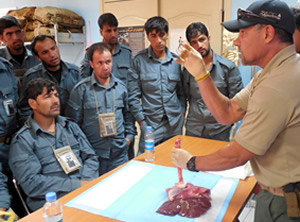History has shown many differences in the way civilians care for casualties and the way the military cares for casualties on the front lines.
With the unfortunate increase of terrorist attacks, private sector violence and natural disasters, both military personnel and civilians benefit from Tactical Combat Casualty Care (TCCC). Knowing what to do after a mass shooting or explosion can save not only your life but increase the chance of survival for those that are injured.
Trauma Training FX’s mobile training team brings current life saving techniques to its clients. The crawl, walk, run training model is followed enabling those with little or no medical experience to confidently finish training knowing that he or she is equipped to save lives.
TCCC Training

Approach to TCCC:
- Identify the causes of preventable death in a high threat environment
- Treat them aggressively
- Combine good tactics with good medicine
T2’ s TCCC course of instruction will take the students through:
Basic Anatomy and Physiology – The student will learn the basic underlying structures in the human body providing a base to build from.
Phases of Care – A standardized approach in caring for a casualty is taught so the non-medical person can understand and apply life-saving principles.
Control of Major Bleeding – Students learn the most rapid way to control arterial bleeding. This is the “Number One Leading Preventable Cause of Death in High Threat Environments”.
Airway Management – Learn how to protect the airway. Prevent the second leading cause of death in a high threat environment.
Treating Breathing Injuries – The “Third Leading Preventable Cause of Death in High Threat Environments” is a tension pneumothorax. Students will be able to recognize and treat this injury.

Abdominal Trauma – Learn how to provide care for an injury in the abdominal region.
Bandaging and Splinting – Learn how to control non-life threatening bleeding and support underlying fractures, as well as open fractures.
Head and Spine Trauma – In the out-of-the-hospital- setting, students receive training to care and manage this casualty.
Burns – Learn that a “True Medical Emergency” is a burn to the airway. Treatment of the different level of burns will be taught.
Shock – The most important part of shock is its prevention. Recognize the signs and symptoms of shock and learn how to treat it in a pre-hospital setting.
Eye Injuries – Learn how to treat an injury to the eye.
Casualty Movement – Learn the different ways to move an injured casualty, by lifts and carries, improvised litters and the use of different litters.
Evacuation Care – The last phase of care is preparing the casualty for transport. Learn how to prepare the casualty, continue monitoring vital signs, and prevent further injuries.
Each training program is specifically tailored to meet the client’s needs. The TCCC guidelines are followed to ensure standard care is maintained. Material can be created for clients in need of training in topics that are not covered in the regular TCCC presentation.
